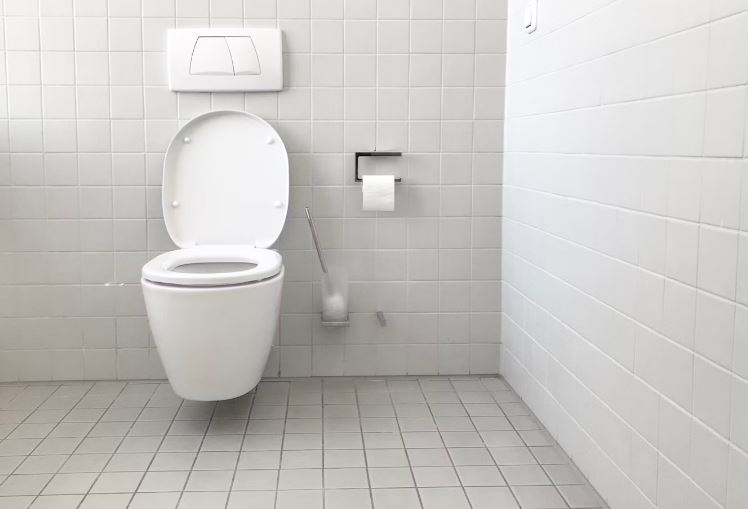-
Shop
- Furniture
- Kitchen
- Bathroom
- Home & Garden

Did you wander into your bathroom first thing in the morning to find the toilet bowl water level lower than you left it the night before?
Or even completely empty?
Fear not, fellow homeowner! This guide will be your lifeline.
I’ll explain why your toilet bowl water level drops overnight and show you how to fix it.
There are a few things that can cause a drop in your toilet bowl water level overnight.
Here are some possibilities:

A leaky flapper valve is the most common cause.
The flapper is the rubber seal at the bottom of the toilet tank that lifts up when you flush, allowing water to enter the bowl.
If it becomes cracked, damaged or worn out, it won’t make a tight seal.
Also Read: Toilet Flapper Leaking After Replacement
This allows water to continuously leak through and drain into the toilet bowl, causing the water level to drop lower overnight while no one is flushing.
Toilets have a drain pipe that connects to the home’s vent system, which leads up to the roof.
This vent allows air flow to prevent drain water from getting sucked out of the trap as it exits.
Now if the vent pipe gets clogged with debris, it will not be able to relieve air pressure in the drain line, leading to an air lock that prevents waste water from fully leaving the toilet bowl.
This causes the water level to rise over multiple flushes.
And eventually the rising water spills over the trap and drains completely, leaving an empty bowl overnight.
The bowl ring is a ring of black molded wax that forms the watertight seal between the bottom of the porcelain bowl and the toilet drain flange in the floor.
This ring can deteriorate over time.
This can happen when you are installing or removing the toilet multiple times or shifts in the house’s foundation.
As the ring melts, it loses its ability to stick properly.
This allows the water to seep through the cracks in the seal, ending up on the bathroom floor.
In rare cases, a cracked toilet bowl itself can be the source of the leak.
Also Read: Is A Cracked Toilet Bowl Dangerous?
You’d likely see signs of water damage around the base of the toilet if this is the case, as most toilet bowl cracks start at the weakest structural joints near the floor flange.
Years of use put pressure on the rigid porcelain material, causing it to crack where it’s firmly bolted to the drain opening.
The crack then spreads slowly upward along the bowl.
This will get worse over weeks or months as the crack grows.
Here’s how to address each of the causes I mentioned:
Start by turning off the water supply line behind the toilet and flushing to empty the tank.
Then remove the tank lid and detach the flapper chain from the flushing handle lever.
Check the flapper seal closely for any cracks, warping, or softening, and if you notice any deterioration, it’s best to replace the entire assembly.
For minor leaks, you can also try wiping debris off the flapper seal rim or spraying white vinegar around the bottom of the flush valve to clean off hard water mineral deposits.
After that, reattach the chain. Make sure there’s about half an inch of slack.
If it’s too tight, it might lift the flapper too soon and lead to continuous running water.
The toilet vent pipe leads up from the drain line through the ceilings and floors to vent out of your home’s roof. So to clean it, you’ll need to go to the roof.
Locate the vent pipe and carefully clear away any debris like leaves or nests.
You can pour a few gallons of cold water into the vent to flush out any other stuff inside.
Also Check Out: Matte Black Personalized Siphon Jet Toilet
If you suspect blockages further down the vent stack, use an expandable vent cleaning rod with a brush that can snake around pipe corners and scrub the entire pipe interior.
And also replace any damaged vent screening to prevent future debris clogs.
If the bowl ring is worn out, you have to replace it.
Go ahead and completely remove the toilet by unscrewing it from the floor bolts.
Use a plastic putty knife to scrape away the old wax around the drain hole until you reach the concrete below. Look for any cracks or gaps in the ring that’s already there.
Put the new ring and then put the toilet back in place.
If you hear water running even when the toilet isn’t flushed, it could indicate a leak.
You can confirm if the leak is from a crack in the bowl with a dye test.
If it is a leak, you have to replace the entire bowl.
Turn off the water supply and empty the bowl as much as possible with sponges/towels, and disconnect and remove the unit.
Take the measurements and buy a new toilet with the same rough-in distance from wall to drain flange as your old one for easy swap out.
If you’re unsure or uncomfortable tackling the repairs yourself, it’s always best to talk to a plumber.




Leave a comment